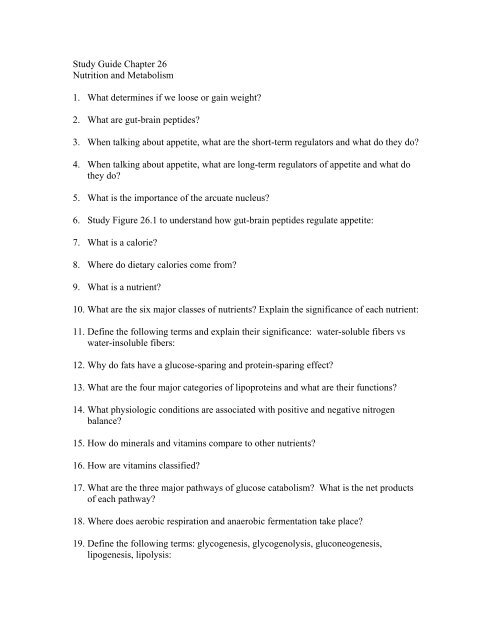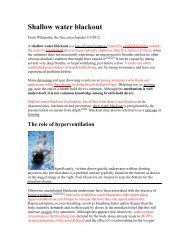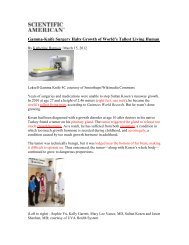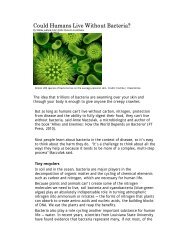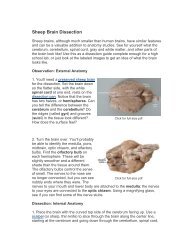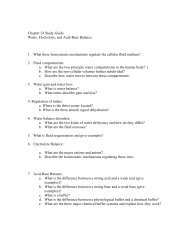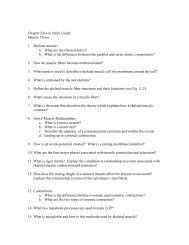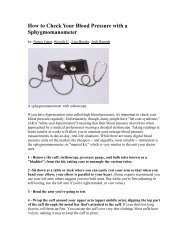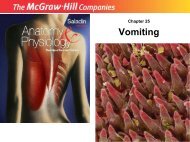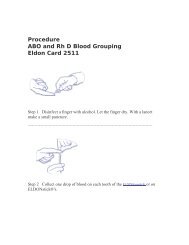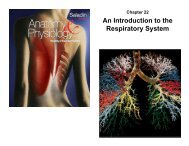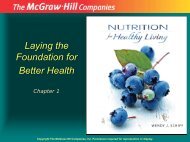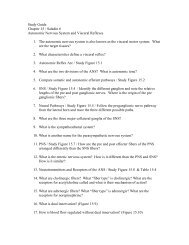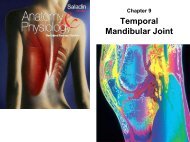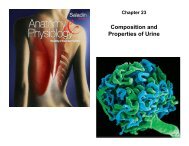Study Guide Chapter 26 Nutrition and Metabolism 1. What ...
Study Guide Chapter 26 Nutrition and Metabolism 1. What ...
Study Guide Chapter 26 Nutrition and Metabolism 1. What ...
- No tags were found...
Create successful ePaper yourself
Turn your PDF publications into a flip-book with our unique Google optimized e-Paper software.
<strong>Study</strong> <strong>Guide</strong> <strong>Chapter</strong> <strong>26</strong><br />
<strong>Nutrition</strong> <strong>and</strong> <strong>Metabolism</strong><br />
<strong>1.</strong> <strong>What</strong> determines if we loose or gain weight?<br />
2. <strong>What</strong> are gut-brain peptides?<br />
3. When talking about appetite, what are the short-term regulators <strong>and</strong> what do they do?<br />
4. When talking about appetite, what are long-term regulators of appetite <strong>and</strong> what do<br />
they do?<br />
5. <strong>What</strong> is the importance of the arcuate nucleus?<br />
6. <strong>Study</strong> Figure <strong>26</strong>.1 to underst<strong>and</strong> how gut-brain peptides regulate appetite:<br />
7. <strong>What</strong> is a calorie?<br />
8. Where do dietary calories come from?<br />
9. <strong>What</strong> is a nutrient?<br />
10. <strong>What</strong> are the six major classes of nutrients? Explain the significance of each nutrient:<br />
1<strong>1.</strong> Define the following terms <strong>and</strong> explain their significance: water-soluble fibers vs<br />
water-insoluble fibers:<br />
12. Why do fats have a glucose-sparing <strong>and</strong> protein-sparing effect?<br />
13. <strong>What</strong> are the four major categories of lipoproteins <strong>and</strong> what are their functions?<br />
14. <strong>What</strong> physiologic conditions are associated with positive <strong>and</strong> negative nitrogen<br />
balance?<br />
15. How do minerals <strong>and</strong> vitamins compare to other nutrients?<br />
16. How are vitamins classified?<br />
17. <strong>What</strong> are the three major pathways of glucose catabolism? <strong>What</strong> is the net products<br />
of each pathway?<br />
18. Where does aerobic respiration <strong>and</strong> anaerobic fermentation take place?<br />
19. Define the following terms: glycogenesis, glycogenolysis, gluconeogenesis,<br />
lipogenesis, lipolysis:
20. <strong>What</strong> are the three main ketone bodies <strong>and</strong> what is the name of the process that<br />
generates these compounds? Where does this occur?<br />
2<strong>1.</strong> How many different amino acids are in the amino acid pool? <strong>What</strong> is the difference<br />
between essential amino acids <strong>and</strong> inessential amino acids?<br />
22. <strong>What</strong> is the absorptive <strong>and</strong> post-absorptive state? How are carbohydrates, fats <strong>and</strong><br />
amino acids regulated in these two states?<br />
23. <strong>What</strong> is the difference between basal metabolic rate <strong>and</strong> total metabolic rate? How<br />
does a fever affect the TMR?<br />
24. <strong>What</strong> is the difference between core <strong>and</strong> shell temperature?<br />
25. Where does most of the heat of the body come from?<br />
<strong>26</strong>. How does the body lose heat?<br />
27. <strong>What</strong> is convection<br />
28. Where is the thermoregulator of the body located? How does it work?<br />
29. <strong>What</strong> is the difference between heat cramps, heat exhaustion, <strong>and</strong> heatstroke? How<br />
can fever cause a “positive-feedback” loop?<br />
30. <strong>What</strong> is hypothermia?<br />
3<strong>1.</strong> <strong>What</strong> lipoprotein transports newly absorbed dietary fats in the lymph?<br />
32. <strong>What</strong> metabolic process splits glucose into two molecules of pyruvic acid?<br />
33. <strong>What</strong> is the physiologic function of VLDL, LDL, <strong>and</strong> HDL?<br />
34. <strong>What</strong> is the relative energy content of fat vs starch?<br />
35. How <strong>and</strong> is glucose stored in the body <strong>and</strong> where is it store?<br />
36. If fats are incompletely oxidized, what do they form?<br />
37. <strong>What</strong> are the sources of cholesterol?<br />
38. <strong>What</strong> is a triglyceride? How are the processed in the body?<br />
39. Can you use proteins to make glucose?
40. How much of the energy in a glucose molecule winds up in an ATP molecule at the<br />
end of aerobic respiration?<br />
4<strong>1.</strong> Which of the following nutrients is most likely to circulate through skeletal muscle<br />
before it ever circulates through the liver?<br />
42. How can you enhance the loss of body heat through conduction?<br />
43. If your body temperature is close to room temperature, how can you loose body heat?


